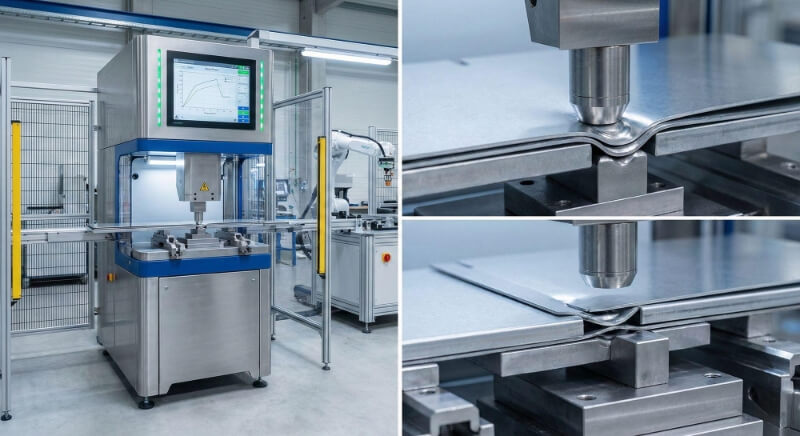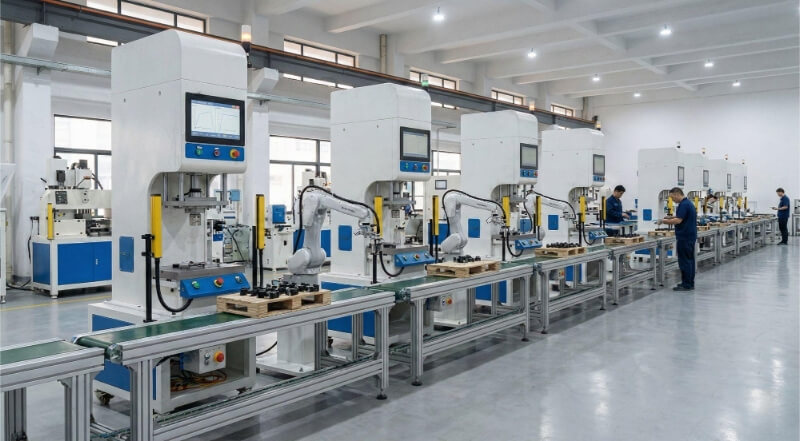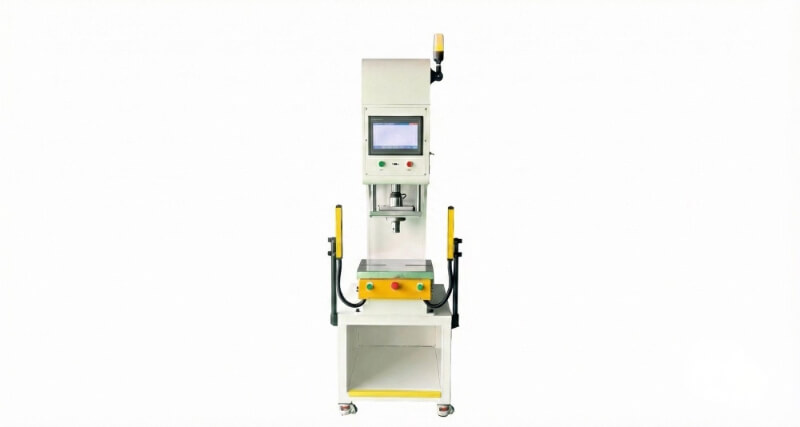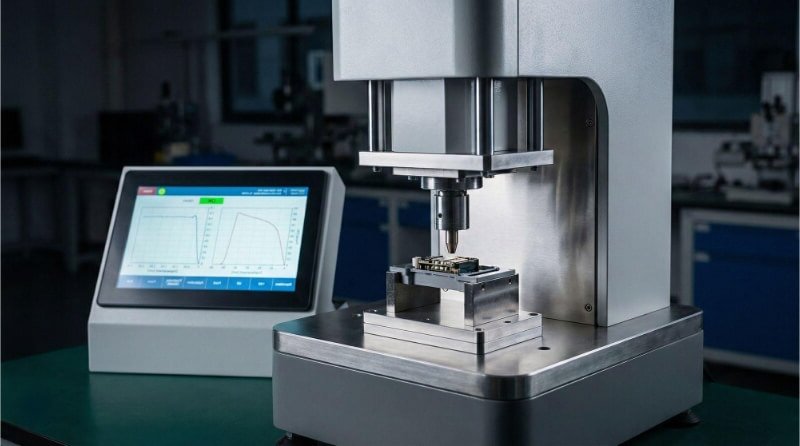多くの企業では、さまざまな業務で強力で信頼性の高い金属が必要とされている。通常の炭素鋼では不十分な場合もあります。錆、重荷重、過酷な作業条件などの問題に直面することもあるでしょう。低合金鋼はこのような問題に対する一つの答えです。この材料は、より優れた強度、より優れた耐摩耗性、要求の厳しいプロジェクトでの性能向上を実現します。
このタイプのスチールは、コストと性能のギャップを埋める。コストパフォーマンスを維持しながら、より大きな応力と熱に耐えることができる。この素材がユニークで価値あるものである理由を説明しよう。

低合金鋼とは?
低合金鋼は、通常1%から8%の少量の元素を添加した鋼の一種です。これらの元素は、鋼の強度、硬度、耐錆性、靭性を向上させるために添加されます。一般的な添加元素はクロム、ニッケル、モリブデン、バナジウムなどです。これらの元素により、鋼は通常の炭素鋼よりも強く耐久性が増すが、ステンレス鋼のような高コストにはならない。
添加元素の種類と量は、鋼の性能に影響する。低合金鋼の中には 溶接.また、割れずに高熱や大きな応力に対応できるものもある。製造業者は、鋼材が何をする必要があるかに基づいて、適切な配合を選択する。
低合金鋼の組成
低合金鋼は、炭素鋼に少量の特定元素を添加して作られる。その目的は、材料を高価にしたり、加工を複雑にしたりすることなく、性能を向上させることである。
低合金鋼に添加される各元素には明確な目的があります。少量であっても、これらの元素は鋼の挙動を著しく改善します:
- クロム (0.5%~1.5%):硬度と耐摩耗性を高める。
- ニッケル (0.5%~3.5%):低温での靭性と性能を向上させる。
- モリブデン (0.1%~0.6%):強度と耐熱性を高める。
- マンガン (0.5%~1.5%):強度を高め、熱処理時の硬化を助ける。
- バナジウム (0.05%~0.15%):鋼を強化し、結晶粒組織を改善する。
- シリコン (0.1%~0.5%):鋼を脆くすることなく強度を高める。
- 銅 (0.2% - 0.5%):湿った状態での錆に対する抵抗力を向上させる。
これらの元素は慎重に選択され、通常8%以下の合金含有率で少量添加される。正確な配合は、鋼の用途によって異なります。
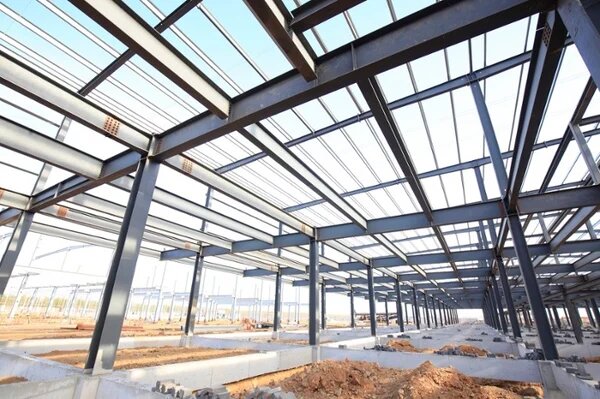
機械的性質
低合金鋼は厳しい環境に対応するように設計されています。その機械的特性は、標準的な炭素鋼よりも強く、難易度が高く、長持ちします。
強度と硬度
低合金鋼は通常、普通炭素鋼よりも高い引張強さと降伏強さを持つ。
- 抗張力:合金や熱処理によって異なるが、通常500~1,200MPa。
- 降伏強度:350~1,000MPaになることが多い。
つまり、これらの鋼材は曲がったり折れたりすることなく、より重い荷重を支えることができる。硬度も向上している。例えば
- モリブデンとバナジウムの添加により、ロックウェル硬度は鋼種と処理によって25HRCから40HRC以上になる。
延性と靭性
低合金鋼は強度と成形性のバランスが良い。
- 破断伸度:一般的には12%から25%の間で、これは鋼材が破断する前に伸びる可能性があることを意味する。
- シャルピーVノッチ衝撃エネルギー:室温で20Jから100J以上、ASTM A633のような強靭なグレードでは-20℃で27J以上。
疲労と耐摩耗性
繰り返される応力は、時間の経過とともに部品の破損を引き起こす可能性があります。低合金鋼は普通炭素鋼に比べて疲労に強い。
- 疲労強度:多くの低合金鋼の場合、表面仕上げ、荷重の種類、荷重の大きさによって異なりますが、およそ250MPaから600MPaです。 熱処理.
- 耐摩耗性:クロムやモリブデンのような元素によって強化され、鋼のマトリックス中でより複雑な炭化物を形成する。
物理的性質
低合金鋼は機械的強度を提供するだけではありません。その物理的特性は、異なる環境下での性能にも影響します。
密度と融点
低合金鋼の密度は普通炭素鋼に近く、約7.85 g/cm³である。このため比較的重く、重量と安定性を必要とする構造部品に役立ちます。
融点は合金元素にもよるが、一般に1425℃~1540℃(2597°F~2800°F)である。例えば
- 4140スチール (標準的な低合金鋼)は1416℃~1460℃付近で溶融する。
- ニッケルやクロムの含有量が多いと融点が高くなる。
電気伝導性と熱伝導性
低合金鋼は、銅やアルミニウムのような純金属に比べ、電気や熱の伝導性が低い:
- 電気伝導性:10% IACS(International Annealed Copper Standard)前後、銅は100%。
- 熱伝導率:通常25~50W/m・K、銅は380W/m・K以上。
このため、低合金鋼は電気配線やヒートシンクには使用されない。しかし、導電率が低いため、高温環境ではより安定する。ケイ素やマンガンのような合金元素は、導電性をさらに低下させるが、構造的安定性を高める。
耐腐食性
低合金鋼は普通炭素鋼よりも錆に強いが、ステンレス鋼ほどではない。耐食性は合金元素の種類と量に依存する:
- クロム (0.5%以上)が不動態酸化被膜を形成し、腐食を遅らせる。
- 銅 (約0.2%~0.5%)は、湿潤または海洋環境での耐性を追加します。
例えば、ASTM A588のような耐候性鋼は、銅、クロム、ニッケルを使用し、大気にさらされた際に保護表面層を形成する。しかし、ほとんどの低合金鋼は、コーティング、亜鉛メッキ、または、耐候性コーティングを必要とします。 絵画 特に屋外や化学物質の多い環境では、長期的な保護が必要です。
低合金鋼の分類
低合金鋼は、エンジニア、メーカー、バイヤーが適切な材料を選択するのに役立つ正式な分類システムによって整理されています。これらのシステムは、鋼の成分、強度、溶接性、耐摩耗性や耐食性を定義しています。
ASTMおよびSAE規格
低合金鋼の分類には、2つの主要なシステムが一般的に使用されている:ASTMとSAEです。
ASTM (米国材料試験協会)は、鋼材の製造方法や試験方法に関する規格を定めている。これらの規格は、建築、構造物、パイプライン、圧力容器などで広く使用されている。
例:
- ASTM A572 - 高強度低合金構造用鋼。
- ASTM A514 - 重機に使用される焼入れ・焼戻し合金鋼。
SAE (自動車技術会)は4桁の数字システムを採用している。機械工学や自動車設計でよく使われる。
例
- SAE 4140 - 優れた強度と靭性、耐摩耗性で知られるクロムモリブデン鋼。
グレード番号と呼称の理解
鋼種番号は単なるラベルではなく、鋼材に何が含まれ、どのような挙動を示すかを知る手がかりとなる。
SAEグレード:
- 最初の2桁は主要な合金グループを示す。
- 下2桁の数字は、おおよその炭素含有量を100分の1パーセントで示す。
ASTMグレード:
- アルファベットと数字を混ぜて、用途と強さのレベルを表す。
高強度低合金(HSLA)鋼
HSLA鋼は低合金鋼のサブカテゴリーです。通常の炭素鋼に比べ、高い強度対重量比、溶接性の向上、耐食性の強化を実現するために特別に開発されました。
一般的なHSLA等級:
- ASTM A572 - 橋や建物に使われる。
- ASTM A588 - 屋外構造物の耐候性で知られる。
- ASTM A709 - 高速道路や鉄道橋の建設に広く使用されている。

利点と限界
低合金鋼にはいくつかの利点がありますが、トレードオフもあります。その両方を知ることは、エンジニアやバイヤーが材料を選択する際に、より賢い選択をするのに役立ちます。
低合金鋼の利点
低合金鋼は、多くの点で普通炭素鋼よりも優れた性能を発揮する。
- より高い強度 つまり、耐久性を損なうことなく、より薄く、より軽い部品を使用することができる。
- より優れたタフネス 衝撃や低温条件下でも部品が割れにくくなります。
- 耐腐食性の向上 過酷な環境における部品の寿命を延ばす。
- 良好な溶接性 そのため、複雑な形状に加工しやすくなっている。
- コスト効率が良い ステンレスやエキゾチック合金に比べて。
潜在的な欠点と設計上のトレードオフ
低合金鋼はあらゆる用途に完璧に対応できるわけではない。
- コストが高い 添加元素により炭素鋼よりも優れている。
- 限られた耐食性 ステンレス・スチールに比べて。
- より複雑な熱処理 目標特性を達成するために必要な場合がある。
- 溶接割れリスク 製造中に適切に管理されない場合。
- 延性の低下 グレードによっては、特に硬化後に。
低合金鋼の用途
低合金鋼は、強度、耐久性、コスト管理を必要とする多くの産業で使用されている。低合金鋼は、応力、熱、過酷な環境にも故障なく対応できる部品の製造に役立ちます。
構造および構造部品
建築では、低合金鋼は梁、柱、支持フレームに使用される。強度重量比が高いため、安全性を犠牲にすることなく構造物を軽量化することができる。HSLA鋼は橋梁、建物、鉄塔によく使用される。また、普通炭素鋼よりも耐候性に優れています。
圧力容器とボイラー
低合金鋼は圧力容器、タンク、ボイラーに広く使用されている。これらの部品は、割れずに高熱と圧力を扱う必要があります。ASTM A387のような鋼は、耐熱性を向上させるクロムやモリブデンを含んでいます。これらの材料はまた、優れた靭性と長期信頼性を提供します。
自動車・重機
自動車産業では、ギア、アクスル、クランクシャフト、サスペンション部品に低合金鋼が使用されている。これらの鋼は、部品を可能な限り軽量に保ちながら、強度と耐摩耗性を提供する。重機械分野では、低合金鋼は以下の部品に使用される。 フレームブレード、耐荷重部品。その靭性により、部品は過酷な使用や衝撃荷重に耐えることができます。
航空宇宙・防衛
低合金鋼の一部は、航空機や防衛機器に使用されている。低合金鋼は、強度、軽量性、信頼性が求められる部品に選ばれている。着陸装置、装甲板、ミサイル・システムなどの部品には、特殊処理を施した低合金鋼が使われることがある。これらの鋼は、故障が許されない過酷な条件下で優れた性能を発揮する。
低合金鋼と他の材料との比較
プロジェクトに適した金属を選ぶ際には、主要な選択肢を並べて比較することが役立ちます。ここでは、低合金鋼が高合金鋼やステンレス鋼と比較して、性能、コスト、用途においてどのように優れているかを簡単に見てみましょう。
| 物件/特集 | 低合金鋼 | 高合金鋼 | ステンレス・スチール |
|---|---|---|---|
| 合金含有量 | 8%未満 | 8%以上 | 10.5%以上のクロム |
| 強さ | 高い | 非常に高い(等級によって異なる) | 中~高 |
| 耐腐食性 | 適度 | 様々(合金化が進むほど良い) | すごく高い |
| 料金 | より低い | より高い | より高い |
| 溶接性 | グッド | 合金含有量が高いため、より硬い可能性がある | 良い(いくつかの成績は他の成績より良い) |
| 典型的な使用例 | 構造、自動車、機械 | 工具、航空宇宙、高応力部品 | 食品機器、医療器具、配管 |
| 耐熱性 | 中程度から良好 | 良い~素晴らしい | とても良い |
| 耐摩耗性 | グッド | 優れた(例えば工具鋼の場合) | グッド |
結論
低合金鋼は性能とコストのバランスが優れています。少量の合金元素を含み、強度、靭性、耐食性を向上させます。建築、自動車、圧力容器などに広く使用されています。多くの鋼種と特性があり、要求の厳しい用途に適合します。
お客様のプロジェクトに適した低合金鋼の選択にお困りですか?私たちのチームがお客様の製造ニーズをサポートします。 お問い合わせ をクリックして、専門家のアドバイスと迅速な見積もりを入手してください。

ケビン・リー
レーザー切断、曲げ加工、溶接、表面処理技術を専門とし、板金加工において10年以上の実務経験があります。シェンゲンのテクニカルディレクターとして、複雑な製造上の課題を解決し、各プロジェクトにおける革新と品質の向上に尽力しています。

